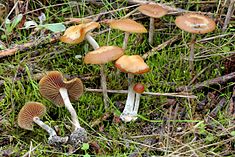Psilocybe cyanescens
| Psilocybe cyanescens | |
|---|---|
 |
|
| Scientific classification | |
| Kingdom: | Fungi |
| Division: | Basidiomycota |
| Class: | Agaricomycetes |
| Order: | Agaricales |
| Family: | Hymenogastraceae |
| Genus: | Psilocybe |
| Species: | P. cyanescens |
| Binomial name | |
|
Psilocybe cyanescens Wakefield |
|
| Psilocybe cyanescens | |
|---|---|
| Mycological characteristics | |
| gills on hymenium | |
| cap is flat | |
|
|
hymenium is adnate or subdecurrent |
| stipe is bare | |
|
|
spore print is blackish-brown to purple |
| ecology is saprotrophic | |
| edibility: psychoactive | |
hymenium is adnate
spore print is blackish-brown
Psilocybe cyanescens (sometimes referred to as wavy caps or as the potent Psilocybe) is a species of potent psychedelic mushroom. The main compounds responsible for its psychedelic effects are psilocybin and psilocin. It belongs to the family Hymenogastraceae. A formal description of the species was published by Elsie Wakefield in 1946 in the Transactions of the British Mycological Society, based on a specimen she had recently collected at Kew Gardens. She had begun collecting the species as early as 1910.
In 1962, a six-year-old girl in Oregon experienced a high fever and seizure after eating mushrooms which were later supposedly identified as Psilocybe cyanescens; she died three days after being hospitalized. Similar cases in children (not resulting in death) have been reported in San Francisco. Despite these incidents, the mushroom is not generally regarded as being physically dangerous to adults. Since all the psychoactive compounds in P. cyanescens are water-soluble, the fruiting bodies can be rendered non-psychoactive through parboiling, allowing their culinary use. However, since most people find them overly bitter and they are too small to have great nutritive value, this is not frequently done.
Psilocybe cyanescens can sometimes fruit in colossal quantity; more than 100,000 mushrooms were found growing in a single patch at a racetrack in England.
Psilocybe cyanescens has a hygrophanous pileus (cap) that is caramel to chestnut-brown when moist, fading to pale buff or slightly yellowish when dried. Caps generally measure from 1.5–5 cm (½" to 2") across, and are normally distinctly wavy in maturity. The color of the pileus is rarely seen in mushrooms outside of the P. cyanescens species complex. Most parts of the mushroom, including the cap and Lamellae (gills, underneath the cap) can stain blue when touched or otherwise disturbed, probably due to the oxidation of psilocin. The lamellae are adnate, and light brown to dark purple brown in maturity, with lighter gill edges. There is no distinct annulus, but immature P. cyanescens specimens do have a cobwebby veil which may leave an annular zone in maturity. Both the odor and taste are farinaceous.
...
Wikipedia
